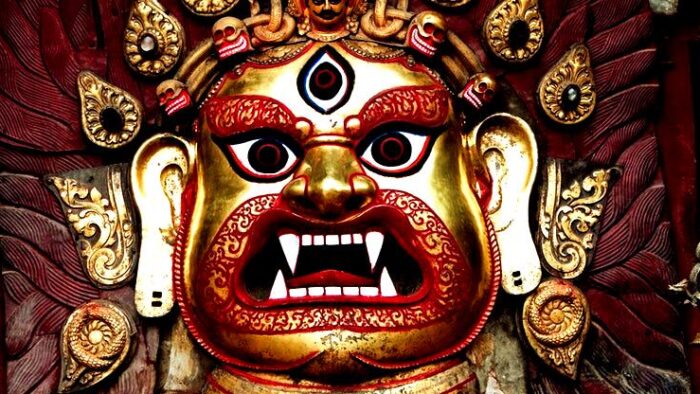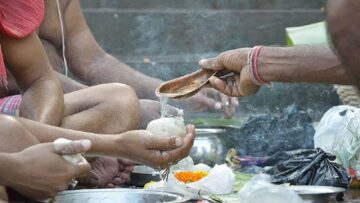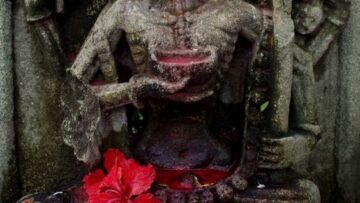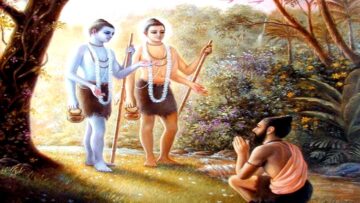Japanese scholar of Sanskrit and Buddhist literature, Minoru Hara, in his study of the Mahabharata lists nearly sixty semantic contexts in which ā*viś is found in the text.
That the term āveśa was already a developed idea indicating an intense psychological state of being possessed becomes clear from reading its applications. Sometimes this term or a derivative is also used to denote such spaces that cause anxiety or bring out a sense of the supernatural.
In the Adiparva, there is a description of a mole hole in the ground near a tree, and the text says “enter it quickly (avisadhvam tvarita); there you will have no fear of fire”.
As early as the vedic brahmana texts, scholars believe, mole holes, termite mounds, and other such sites of non-human activity in the ground were regarded as places of power. Thus, ā*viś captured not merely an entering, but also accompanied an emotional sense of anxiety in the context.
Mahabharata
Of the various instances of possession found in the Mahabharata, there is none as graphic and remarkable as the case of Aśvatthāmā. Of course, this is not the only instance of possession in the Mahabharata, nor of the particular format where a warrior is possessed by a great god and then unleashes terrifying violence.
Aśvatthāmā’s nocturnal raid on the Pandavas caught them off guard. As he was going towards the Pandava camp, he saw an owl in full ferocity (ulukam ghoradarśanam), preying on innumerable crows sleeping on a banyan tree. This was clearly an omen indicating great misfortune and destruction.
The avian carnage is described in great details: beheadings, wings sliced, etc., which seemed to inspire Aśvatthāmā for the great slaughter he was about to precipitate. Kripa tried to dissuade him from his actions, but Aśvatthāmā would not listen and noted that while being a Brahmin he has immense self-control as is appropriate for his caste, the situation now has forced him to give-up his restrain and avenge his fallen comrades. Standing at the gate of the Pandava camp, Aśvatthāmā saw a great-bodied spirit (bhutam mahakayam), as the very embodiment of Śiva in all his destructive splendor.
Aśvatthāmā, however, was unable to recognize this spirit and tried in vain to destroy it with all his weapons. Finally, and suddenly, it dawned on him that his adversary is no ordinary bhuta, but the indestructible, skull-garlanded (kapālamālinam) Rudra and decided to surrender completely and thoroughly to the great god.
He offered himself as a sacrifice to Śiva, with the result that his self-identify merged so seamlessly with the deity – he was already a partial incarnation of Śiva – that it became a complete possession. The text reads:
“Having thus spoken to the great archer, the Lord possessed his body and gave him the best stainless sword. Then, possessed by the Lord, he again blazed up with splendor, With that splendor fashioned by the deity, he assumed a body for battle.” Thus possessed by the ferocious Rudra, Aśvatthāmā “split the feet of one, the hips of another; he broke the ribs of others like the Terminator (antaka) set loose by Time”.

Bhairava in Nepal. (Source: www.researchut.com)
Without being swayed by sentimentalism or morality, here we must understand that Rudra is by itself the force of tremendous destruction and the right deity for the purpose Aśvatthāmā had in mind.
But not all possessions are by deities, they could be by ethereal spirits of various natures, capability and competency, and sometimes, it may be even by the invoking of a particularly great and powerful spirit for a specific action. Consider the following excerpt from the Aryanyakaparva of the Mahabharata:
“The Dānavas inform Duryodhana of his divinity [that he is a gift from Śiva]. They tell him that other asuras will take possession [praveksyanti] of Bhisma, Drona, Krpa, and the others; and possessed [āvistāh] by them they will fight his enemies ruthlessly… Pitiless, possessed by the Dānavas, their inner souls overwhelmed they battle with their relations and cast all love far off… moreover, groups of Dānavas and Rākshasas will take on lives in the wombs of the baronage [ksatrayonisu] and fight mightily with enemies…They also tell Duryodhana that whenever fear arises in him from Arjuna, for that too they have devised a means: the soul of the slain Naraka will take the body of Karna in order to slay Arjuna.. These Kaurava heroes possessed were overcome by passion and darkness and sought the death of Phalguna (Arjuna). Thus, Bhisma, Drona, Krpa and the others were no longer friendly towards the sons of Pandu, now that their minds were taken over by Dānavas [danavakrantacetasah].” [Mahabharata by Johannes Adrianus Bernardus van Buitenen]
In other words, it was not merely Kauravas, who were fighting the war, but also asuras and rakshashas who had taken control over the army, an aspect clearly missed in popular readings of the Mahabharata.
Apart from these we also have the story of Nala and Damayanti, where the former gets possessed by Kali (the personification of Kali Yuga), who perverts his mind; we also read about Vipula Bhargava, who is instructed to protect the wife of his Guru, Devasarman, from the sexual advances of Indra. The text says Vipula knew that Indra could not be kept at bay using any physical barriers.
So, he decides to enter her mind and body, through her eyes, in what can be called a kind of hypnosis maybe, like wind enters an empty space, and then using his subtle body enters Ruci’s limbs using the power of Yoga, yogenanupravisya, in which he was clearly an adept.
When Indra arrives stealthily, he is taken off guard when he heard Ruci responding in eloquent Sanskrit. He immediately suspects something and using his own divine sight, divyena caksusa, finds Vipula in possession of Ruci’s mind and body.
Scared that the ascetic may utter a curse, Indra trembles and returns back to his own realm. The important aspect and lesson we gather from this story is that not only is possession an aspect of interaction between a deity and an individual, or an ethereal being and a human, but can also be employed by yogis to enter and control someone else’s mind and body. We shall see more of this later.
The Beginning
Possession was a prevalent idea even in the vedas, and a careful study of the vedic verses help us to understand how this unique and important idea was employed to describe matters of theophany. Consider the following verses from the Rig Veda:
Vastospate prati janihy asman svaveso anamivo bhava nah [RV 7:54.1]
Respond to us, O Lord of the house; may you be easy of entry [sv-avesah]. Do not bring us disease.
Somarudra vi vrhatam visucim visucim amiva ya no gayam a vivesa [RV 6.74.2]
Soma and Rudra, drive away in all directions the illness that has possessed our dwelling.
So apam napad anabhimlatavarno ‘nyasyeveha tanva vivesa [RV 2.35.13]
Apam Napat, Agni as son of the waters, of unfading color, *entered* this world as it (entering) another’s body
munayo vatarasanah drse kesidram jyotir ucyate | vatasyanu dhrajim yanti yad devaso aviksata || [RV 10..136.2]
The munis, reined by the wind, wear yellow garments. They glide with the wind when the gods have possessed [them].
In the Upanishads, which were a distillation of the vedic philosophy, we find the idea used to explain the mechanics of creation. The īśopaniṣad describes how the inert world was entered, permeated, possessed and animated by the Lord (isa):
isavasyam idam sarvam yatkimca jagatyam jagat.
The śvetāśvataropaniṣat states that the world is filled with the purusha, implying that it was empty before being possessed by the Divine:
Yasmat parama naparam asti mincid yasman
naniyo na jyayo ‘sti kimc it | vrkseva stabdho
divi tisthaty ekas tenedam purnam purusena sarvam ||
There is a strong textual evidence that one of the earliest and most prevalent ways of describing the Universe and world was an act of possession, first by the Supreme, and then by deities. The Aitareya Upanishad tells of a man possessed by deities, but governed centrally by a greater and original deity.
It says: “In the beginning this world was the Self, one alone, and there was no other being at all that blinked an eye. He thought, let me create the world.” [atman va idam ek evagra asin nanyat kimcana misat | sa iksata lokan nu srija iti] Eventually, the deities were created, who then became hungry, and wanted a place where they could establish themselves and “eat”. First a cow was brought, then a horse, but both proved inadequate, so a man was created. “Then he, the atman told them to enter into their respective dwelling [ta abravid yathayatanam pravisata]. So, fire became speech and entered the mouth; the wind became breath and entered the nostrils; the sun became sight and entered the eyes; the quarters became hearing and entered the ears; moon became mind and entered the heart; death became the in-breath and entered the navel..” etc. Then, the atman thought these deities cannot function without it, so it pondered from which place should it enter man and then decided to “split open the head at the point where the hairs part and entered through that gate” [sa etam va simanam vidaryaitaya dwara prapadyata].

The Rishis, who composed our Upanishads were clear that the world and the human being is animated by a great act of original possession, where the Divine enters into and controls the activities of this world, albeit from behind a veil, rendering of which is the key to adhyatmic realizations. While some may look at this as mere doctrinal position, it however has undeniable application in the ritualistic heart of Sanatana Dharma. Consider for example the popular practice of nyāsa for a deity, whether Vedic or Tantric.
The intent of nyāsa is to correctly place, by using the power of mantra, the appropriate form or forms of a deity or deities in various parts of the body or even an object or image. It is only after a nyāsa, successful one it is assumed, that the sādhaka enters into a state of being possessed, or a communion, when he is suited for further ritual engagement. Consider this excerpt from the nyāsa to be performed before Rudradhyāya:
prajanane brahma tisthatu | padayor visnus tisthatu | hastayor haras tisthatu | bahvor indras tisthatu | jathara ‘gnis tisthatu | hrdaye Śivas tisthatu | kanthe vasavas tisthantu | etc.
May Brahma be established in my organ of generation. May Vishnu be established in my feet. May Hara be established in my hands. May Indra be established in my arms. May Agni be established in my belly. May Śiva be established in my heart, etc.
Clearly, executed by the right kind of sādhaka, the above is nothing, but an invocation for possession, which results in divination of the body. In Tantra, too nyāsa constitutes an integral part of ritual purification of the five elements that are supposed to compose human beings. Same applies even for mudrā.
The great Tantrika masters from Kashmir, Abhinavagupta and Kshemaraja considered mudrā as a “way of accessing higher layers of the cosmos, meaning individual consciousness is absorbed into or possessed (āvesa) by mudrā…one’s own body becomes possessed by the mudrā and mantra, which can be read as becoming a channel for higher cosmic powers, which erode the sense of individuality and distinction.” [Gavin Flood, 1993.].
Abhinavagupta, further, says that all actions of an awakened one are in fact mudrā! Not only mudrā, but even asana was considered by Kshemaraja as something more than mere posture, as a manifest power (bala) of the supreme Shakti.
Possession in Yoga
We hear of possession also in the Yogic context where an individual is able to enter into another, and take control of the latter’s mind or body. We have already seen the example of Vipula Bhargava and Ruci. In the medieval era, we hear of Adi Shankara possessing the body of a dead king during a celebrated debate. Similarly, even the popular Vetālapañcaviṃśati is replete with stories of possessions of one living individual by another, or by spirits of different kinds.
Specifically in the 3rd adhyaya of Patanjali’s Yogasūtras, we find the chapter dealing with supernormal powers – vibhuti, siddhi – gained as a result of Yoga, describe in one telling verse how entering (āvesa) of ones chitta into another’s body becomes possible.
It is the dilution of the karmic-web in a Siddha or a Yogic adept, that occurs due to frequent and long experience of samadhi, which gives him the ability, or power, according to Vyasa, to make his chitta (mind-stuff, for lack of better word) enter into the body or mind of another, irrespective of physical distance, and govern the possessed individual, physically, if the power is that strong, or mentally, by introducing thoughts into the mind. Different commentators have given more detailed descriptions of the process, but essentially are in unison when accepting the validity of this.
Narayana Tirtha, author of Yogasiddhantachandrika, says that after a thread that connects the chitta to the body of the yogi is severed, the experience of entering another body, whether dead or alive, is like entering a new country. Moreover, there is a term used in the Yogasūtras – samyama – while describing various siddhis.
This can be broadly understood, from an experiential point of view, to include and combine three central limbs of yoga: dharana, dhyana and samadhi. For example, the text says, when a Yogi practices samyama on different kinds of strengths, he may acquire the strength of an elephant.
Samyama follows the same psychological mechanism of possession, of the essence of an object or attribute, entering into and pervading the consciousness of the yogi, who by dint of his superior and immobile concentration is able to actualize the attribute inside his being.
It is also important to note, and this is another vital differentiation between casual pop-ideas of possession and that which comes to us from śāstras, is that the act can be initiated either by the possessor or the possessed. In case of Yogic possession of another mind-body, it is mostly the possessor who acts, while in the case of samyama or non-individualized, attributive possession, the Yogi calls into his being those attributes, which he wants to manifest inside him.
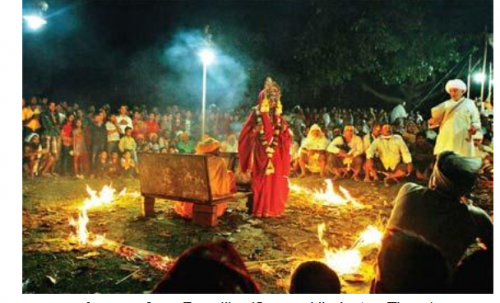
A scene from Ram lila. (Source Hindustan Times)
Similarly, in the previous instances of possession by deities, of which evidences are plenty, practically, it is more often an invocation by the possessed, which results in the altered state. Even the final section of the Brahmasūtra describes a liberated being as having the ability to enter another body, as a flame can enter another wick.
In the YogaVāsiṣṭha, we find a brilliant passage where Vāsiṣṭha tells a child Rama about King Sikhidhvaya and his devoted wife Cudala, while illuminating how Kundalini Shakti is used to enter into different states, beings or even other forms of matter.
“Like a smoke rising from fire, the kundalini shakti, freed through the nadis, rising from the muladhara, merges into the cosmic void (vyom). This citizen (nagari, that is Kundalini), like a puff of smoke is a spectacle vibrating internally, enveloped by an ego-sense (ahamkara), which comprises the living being embraced by manas and buddhi. She is capable of moving about at will, entering into (niryati) a lotus stalk, a mountain, grass, a wall, a rock, the sky, or the surface of the earth. She alone becomes consciousness, establishing itself step by step, filed from beginning to the end with its fluid essence (rasa). Immersed in this essence, it becomes like a leather bag in water, O Rama, this quickly assumed any desired shape, as she places in the mind of an artist lines of certain shape. Due to influence of a resolute intention (drdhabhava) she develops an internal skeleton. Like a fetus growing inside a mother, this extremely subtle energy becomes established in its own germinated sprout. O Raghava, know this truth which has been formulated by the learned, that the energy of a living being (jivashakti) can turn itself into anything, from the Mt. Meru to a patch of grass.”
In another part of the text, Vāsiṣṭha describes that when prana is led into a state of stability by engaging in the practice of breath retention after exhalation at a distance of 12 fingers from the mouth, one can enter (pravisati) into the body of another person.
This is how a Yogi is able to transform his shakti and enter into or possess another being or object and bring the same under his control.
Some Vaisnava literature describe possession-like states generated by intense emotion – bhāvāvesa. Even today there can be seen examples of bhāvāvesa during rural performances of Krishna or Rama lila, where the actor gets possessed, or completely absorbed in the essence of the deity due to his extreme emotional engagement.
However, while true āvesa is full-fledged entering of a deity or force into another individual, thus altering his individuality completely, bhāvāvesa is a more specific experience, where the self-identity of the subject is not necessarily threatened.
Apart from bhāvaseva we also have a proximal phenomenon of extreme rasāvesa, where possession is induced onto a practitioner using, inter alia, one of the nine fundamental rasas of existence. More details of this can be found in mudrākosa of Jayadrathayamala.
Possession in Tantra
In Tantric literature possession acquires a more central status, which ranges from the exalted references of samāveśa, to the more mundane, but rampant instances of oracular possession. Alexis Sanderson, in his seminal work on rare Tantric and Hatha Yogic texts, describe tantric initiates venturing into settings where
“the uninitiated were in the greatest danger of possession: on mountains, in caves, by rivers, in forests, at the feet of isolated trees, in deserted houses, at crossroads, in the jungle temples of the Mother Goddesses, but above all in the cremation grounds… [These ritualists] moved away from the domain of autonomy and responsibility idealized by the Mīmāṃsākas into a visionary world of permeable consciousness dominated by the female and the theriomorphic.”

A homa in a pyre during Simhasta Kumbha in Ujjain’s Chakratirtha Smashan. A Kapalika practice. (Source; Dainik Bhaskar)
The kāpālika text Saivaparibhasa states succinctly, “kāpālikas attain samayam, (equipoise) through samāveśa. Just as spirits possess people in ordinary life, in the same way Śiva, possesses those who are liberated.” Of course, the siddhāntika saivaism differed from this position, considering it a dangerous statement, and categorized and moderated different types possession by applying suitable doses of spiritual discipline.
But, scholars are certain that according to Kashmiri Saivism, liberation was a product of samāveśa and not samadhi, the latter being a static and temporary equipoise. Especially, in the non-siddhāntika variety, moksa was definitely considered as a special kind of samāveśa or possession by the Supreme.
There are evidences that disembodied masters could enter into the body and mind of a disciple during initiation ritual – shaktipatha, and this would be visible to others by symptoms such as convulsions (ghurni, kampan), and/or loss of normal consciousness, while the degree of possession revealed by the tivrata – intensity – of these signs.
Entering into the fourth stature of consciousness, Turiya or Turiyata, was possible, according to the Tantric tradition, only when uninterrupted ontological condition of samāveśa has been perfected over a long time.
In short, by general agreement practitioners thought it was unlike for a sādhaka to enter into the highest states of liberation without being absorbed or possessed by a higher deity, or the Supreme, in this case, Śiva.
Professor Fredrick Smith mentions a text named Brhaddevata, probably from 1st millennium C.E., dealing with the deities of the Rig Veda, which states that the highest performance of the sacrifice entails “fully introducing the deity into the mind” (manasi samnyasya devatam); in other words being possessed completely by the deity to whom the sacrifice is being offered.
This is essentially non-different from the later Tantric idea that only perfection of samāveśa would allow the deity to inhabit, instruct, guide and direct the sādhaka on how exactly the worship is to be executed to its complete satisfaction.
Therefore, the colloquial dictum, only Śiva knows how to worship Śiva, or becoming (the deity) is better and higher than normal worship.
There is, of course, plenty more literature and angles through which possession can be viewed, examined, and understood; those interested may take up the study on their own.
In the perspective of Sanatana Dharma, unlike in Judeo-Christian tradition, possession in its true scope and origin is not only a fundamental theological mechanism, but also an indicator of liberation and enlightenment – at least of some kind, because these two English words are nothing more than loose, modern day approximations covering a wide range of complex and differing spiritual states described in the śāstras.
References
- Deity and Spirit Possession in South Asia, Frederick M. Smith
- The identity and significance of the valmikikavapa in the Vedic sacrificial ritual, Frederick Smith and S.J.Carri.
- The Sauptikaparvan of the Mahabharata: The Massacre at Night, W.J.Johnson.
- Pleasure and the emotions in Tantric Saiva Soteriology, Alexis Anderson.
Explore A brief study of Possession in Hinduism Part I
This series was first published on India Facts.
Featured Image Credits: steemitsteemitsteemitsteemitsteemit
Disclaimer: The facts and opinions expressed in this article are the personal opinions of the author. Indic Today does not assume any responsibility or liability for the accuracy, completeness, suitability, or validity of any information in this article.
Disclaimer: The opinions expressed in this article belong to the author. Indic Today is neither responsible nor liable for the accuracy, completeness, suitability, or validity of any information in the article.

